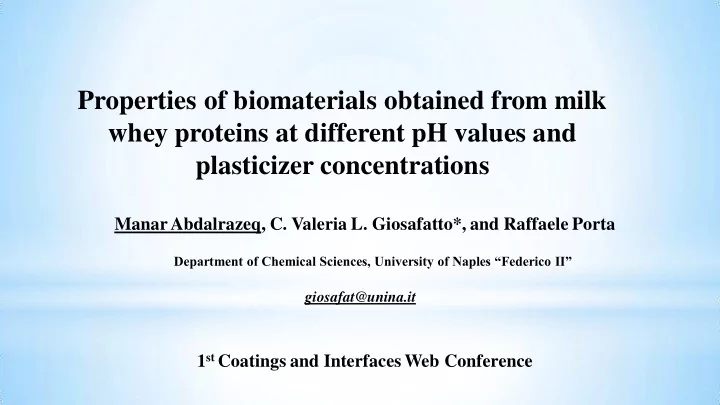

Properties of biomaterials obtained from milk whey proteins at different pH values and plasticizer concentrations Manar Abdalrazeq, C. Valeria L. Giosafatto*, and Raffaele Porta Department of Chemical Sciences, University of Naples “Federico II” giosafat@unina.it 1 st Coatings and Interfaces Web Conference
Plastic pollution • Traditional plastics are not biodegradable • Environmental pollution (air, water, soil) is harmful for animals and other living organisms • By 2050, the oceans will contain more plastic than fish by weight plasticpollutioncoalition.zendesk.com
Anti-pollution strategy
BIOPOLYMERS Polysaccharides Proteins Aliphatic polyesters Pectins Soy proteins Polylactic acid (PLA) Cellulose Milk whey Proteins (MWPs) Chitin/Chitosan Bitter vetch proteins Polyhydroxyalkanoates (PHA) Starch Phaseolin Alginate Zein Collagen Xanthan
Dairy Industry Worldwide a large amount (180 to 190×10 6 tons/year) of by-product as Milk Whey (MW) is produced during casein coagulation, causing environmental pollution. • MW High organic content Free from toxic agent Protein source
MWP-BASED FILM PREPARATION MWPs (1% proteins (stock solution)) dissolved either at pH 12 or pH 7 B) MWPs heating (80°C for 25 min) A) Unheated MWPs (25°C for 25 min) Cooling down to room temperature Preparation of Film Forming Solutions (FFSs) by adding 10-50% glycerol (GLY) as plasticizer Casting of FFSs Study of the Zeta-potential and mean Characterization of the derived films particle size of FFSs
Visual inspection of the derived MWP(1%)-based films
Zeta-potential and Z-average of either heated or unheated MWP FFSs Z-average Zeta potential (d.nm) (mV) MWP FFSs pH 7 pH 12 pH 7 pH 12 + 30% GLY, heated 147.1 ± 18.4 418.9 ± 31.9 -27.0 ± 1.0 -35.3 ± 2.1 + 30% GLY 1127.0 ± 167.4 610.2 ± 56.5 -21.6 ± 0.4 -35.8 ± 2.6 + 40% GLY, heated 110.5 ± 21.1 415.4 ± 6.7 -29.1 ± 0.6 -35.4 ± 2.8 + 40% GLY 522.6 ± 102.5 519.2 ± 30.8 -22.9 ± 0.3 -35.9 ± 2.4 + 50% GLY, heated 350.1 ± 13.8 403.9 ± 19.7 -27.0 ± 0.1 -36.2 ± 3.3 + 50% GLY 516.3 ± 23.1 526.1 ± 38.6 -24.0 ± 0.4 -35.6 ± 2.9
Mechanical properties of MWP-based films prepared at pH 12 Mechanical properties of MWP-based films prepared at pH 7
Opacity (A 600 nm / mm ) of different film types MWP films Opacity (A600nm /mm) +30% GLY, heated, pH 12 1.18 ± 0.64 +30% GLY, pH 12 2.65 ± 0.11 +40% GLY, heated, pH 12 1.23 ± 0.05 +40% GLY, pH12 2.07 ± 0.25 +50% GLY, heated, pH 12 1.57 ± 0.13 +50% GLY, pH 12 2.20 ± 0.81 +40% GLY, heated, pH 7 1.66 ± 0.01 +50% GLY, heated, pH 7 1.27 ± 0.01 polypropylene* 32.02 ± 3.35 cellulose triacetate* 0.54 ± 0.09 *Values from Giosafatto et al. 2018
Film moisture content (%) and film moisture uptake (%) of MWP-based films prepared at pH 12 MWP film Moisture content (%) Moisture uptake (%) +30% GLY, heated, pH 12 15.24 ± 1.32 10.31 ± 1.00 +30% GLY, pH 12 20.35 ± 1.20 15.05 ± 0.73 +40% GLY, heated, pH 12 18.39 ± 1.94 15.70 ± 0.04 +40% GLY, pH 12 25.65 ± 0.69 15.98 ± 2.10 +50% GLY, heated, pH 12 18.93 ± 3.30 14.90 ± 0.66 +50% GLY, pH 12 29.50 ± 2.30 16.56 ± 0.77 +40% GLY, heated, pH 7 21.43 ± 0.32 9.12 ± 0.85 +50% GLY, heated, pH 7 33.27 ± 0.50 9.01 ± 0.72
Conclusions Rod-like microstructures, forming fine-stranded fiber-like matrices, obtained under alkaline conditions of MWPs lead to the production of handleable biomaterials without any heating and with a minimum concentration of GLY (30%) At pH 7 it was necessary to previously heat at 80°C for 25 min the MWP-containing FFS and to increase the GLY concentration at least 40% to obtain handleable biomaterials The developed experimental conditions allowed to produce hydrocolloid films with higher flexibility and transparency with respect to the MWP-based films obtained at pH 7 following FFS heat treatment
Manar Abdalrazeq
Recommend
More recommend